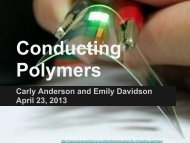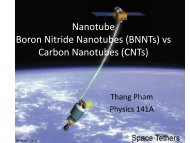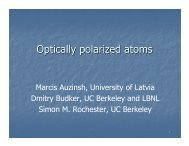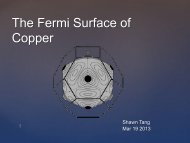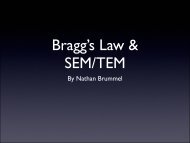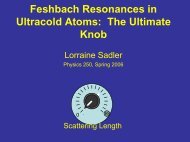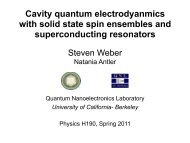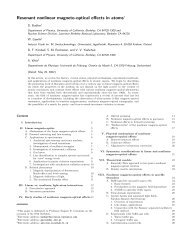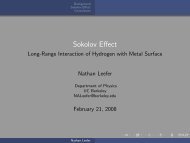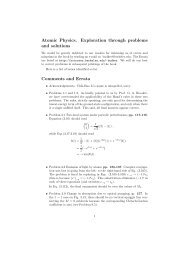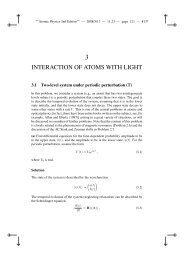Atomic Tests of Discrete Symmetries at Berkeley - The Budker Group
Atomic Tests of Discrete Symmetries at Berkeley - The Budker Group
Atomic Tests of Discrete Symmetries at Berkeley - The Budker Group
You also want an ePaper? Increase the reach of your titles
YUMPU automatically turns print PDFs into web optimized ePapers that Google loves.
∼ 10 4 times higher counting r<strong>at</strong>e compared to the pulsed PNC experiment[12]. With a<br />
similar technique and a total integr<strong>at</strong>ion time <strong>of</strong> 20 hours, this should allow us to reach<br />
a st<strong>at</strong>istical sensitivity to the weak m<strong>at</strong>rix element <strong>of</strong> ∼10 mHz.<br />
<strong>The</strong> future <strong>of</strong> dysprosium as a labor<strong>at</strong>ory for PNC studies depends crucially on the<br />
results <strong>of</strong> the current phase <strong>of</strong> the experiment. If the effect is “around the corner," (i.e.<br />
|H w | ∼ 1 Hz) Dy can still contribute to the study <strong>of</strong> both nuclear-spin-independent<br />
effects (via isotopic comparisons <strong>of</strong> the PNC effect), and to the study <strong>of</strong> the nuclearspin-dependent<br />
PNC (via comparison <strong>of</strong> the effect on different hyperfine transitions).<br />
If the effect is suppressed even more strongly, it appears th<strong>at</strong> Dy would not have<br />
sufficient advantages over other systems for PNC studies. However, the unique situ<strong>at</strong>ion<br />
in Dy could also be applied in other studies th<strong>at</strong> benefit from near-degeneracy <strong>of</strong> longlived<br />
opposite parity Zeeman sublevels, forming a well isol<strong>at</strong>ed two-level system with<br />
adjustable parameters (level spacing, projection <strong>of</strong> angular momenta <strong>of</strong> the crossing<br />
sublevels, their effective width, etc.).<br />
PARITY NONCONSERVATION IN YTTERBIUM<br />
Ytterbium (Yb; Z = 70) is another example <strong>of</strong> a unique system in which to study <strong>at</strong>omic<br />
PNC. Yb was first proposed as a system for studying PNC by one <strong>of</strong> Pr<strong>of</strong>essor Commins<br />
former gradu<strong>at</strong>e students, David DeMille [18], while he was <strong>at</strong> <strong>Berkeley</strong>.<br />
Like Dy, Yb is a rare-earth <strong>at</strong>om and has seven stable isotopes, including two isotopes<br />
with non-zero nuclear spin. However, because the ground st<strong>at</strong>e <strong>of</strong> Yb has a closed 4 f<br />
shell (in addition to a closed 6s shell), the low-lying energy levels more closely resemble<br />
those found in alkaline-earth <strong>at</strong>oms such as Ba and Ca. This makes the calcul<strong>at</strong>ions<br />
significantly more reliable than those done in other rare-earth <strong>at</strong>oms such as Dy and Sm.<br />
In Yb, the weak interaction mixes the even-parity 5d6s 3 D 1 st<strong>at</strong>e with the odd-parity<br />
6s6p 1 P 1 st<strong>at</strong>e (see Fig. 3). <strong>The</strong> mixing between these two st<strong>at</strong>es is expected to be<br />
large due to rel<strong>at</strong>ively small energy separ<strong>at</strong>ion between the two st<strong>at</strong>es (≈ 600cm −1 ) and<br />
favorable configur<strong>at</strong>ions among the st<strong>at</strong>es (the 1 P 1 st<strong>at</strong>e is not a pure 6s6p configur<strong>at</strong>ion<br />
and contains ≈ 15% 5d6p; allowing mixing between the 6s electron in the 3 D 1 st<strong>at</strong>e and<br />
the 6p electron in the 1 P 1 st<strong>at</strong>e).<br />
This mixing leads to a small electric-dipole (E1) transition amplitude between the<br />
6s 2 1 S 0 ground st<strong>at</strong>e and the 5d6s 3 D 1 st<strong>at</strong>e. <strong>The</strong> size <strong>of</strong> this PNC-induced transition<br />
amplitude was estim<strong>at</strong>ed in DeMille’s original proposal to be ≈ 10 −9 ea 0 (≈ 100 times<br />
larger than in Cs) [18]. This estim<strong>at</strong>e has been confirmed by more elabor<strong>at</strong>e calcul<strong>at</strong>ions<br />
<strong>of</strong> M.G. Kozlov, S. Porsev, and Yu. Rakhlina, [19] and B. P. Das [20].<br />
In addition to the large enhancement <strong>of</strong> the PNC effect, the transition also has a highly<br />
suppressed magnetic-dipole (M1) amplitude (≈ 10 −4 µ B [21]), and a moder<strong>at</strong>ely sized<br />
Stark-induced amplitude (2.18(33) × 10 −8 ea 0 /(V /cm) [21]) allowing the use <strong>of</strong> the<br />
Stark-interference technique in an <strong>at</strong>omic beam, which has been successfully employed<br />
for cesium [22].<br />
A schem<strong>at</strong>ic <strong>of</strong> the appar<strong>at</strong>us is shown in figure 4. A dc electric field mixes oppositeparity<br />
st<strong>at</strong>es and cre<strong>at</strong>es a Stark-induced E1 transition amplitude between the 1 S 0 and



